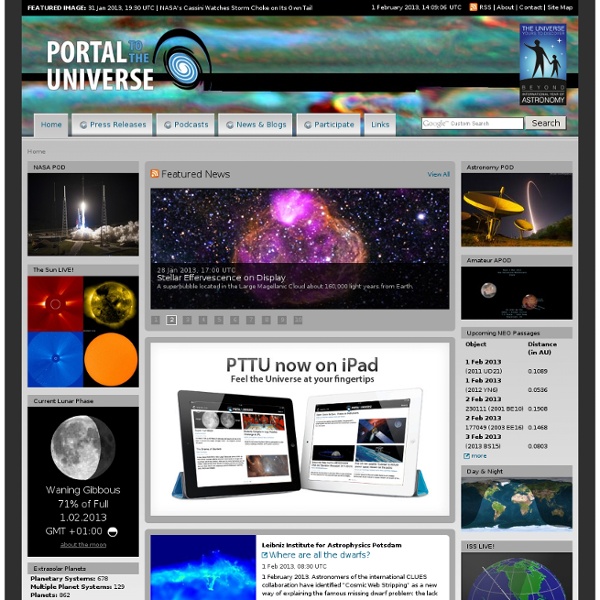



Australian Aboriginal Astronomy: When Giant Fish Leaves the Sky I would like to introduce our readers to a video presentation made by John Morieson and Alex Cherney about the astronomy of the Boorong clan (of the Wergaia language in northwest Victoria). John Morieson is an historian in Victoria who has spent many years researching the astronomy of the Boorong and other Victorian Aboriginal groups. He completed an MA thesis at the University of Melbourne in 1996, where he reanalysed the work of William Edward Stanbridge regarding Boorong astronomy. Alex Cherney is an amateur astronomer and astrophotographer in Melbourne. This video was presented at the 2011 SEAC conference in Portugal.
Total Solar Eclipse 2012 - Total Solar Eclipse 2012 Education Resources SVS Animation 4000 - Moon Phase and Libration, 2013 Dial-A-Moon The animation archived on this page shows the geocentric phase, libration, position angle of the axis, and apparent diameter of the Moon throughout the year 2013, at hourly intervals. Until the end of 2013, the initial Dial-A-Moon image will be the frame from this animation for the current hour. More in this series: 2014 | 2014 South | 2013 South | 2012 | 2011 The jagged, cratered, airless lunar terrain casts sharp shadows that clearly outline the Moon's surface features for observers on Earth. The Moon always keeps the same face to us, but not exactly the same face. The word comes from the Latin for "balance scale" (as does the name of the zodiac constellation Libra) and refers to the way such a scale tips up and down on alternating sides. The Moon is subject to other motions as well. The most noticed monthly variation in the Moon's appearance is the cycle of phases, caused by the changing angle of the Sun as the Moon orbits the Earth.
Solar System Scope Stellarium Science & Environment - How big is space? Big questions demand big answers. And here at Future we have a hard time thinking of a question bigger than: how big is space? So, we set about trying to illustrate it. The resulting picture is so large that we could not squeeze it all on to one image in Photoshop. Instead, we had to create several sections and stitch them together for you. Printed out, the graphic spans 27 pages of A4 paper. But even at this size we only managed to get to the edge of our Solar System – known as the heliosphere. Yet even within this relatively small corner of space, there is a lot packed in there. What is the most distant man-made object? Scroll (and scroll... and scroll) through our monster graphic to explore our cosmic neighbourhood. And if you want to check out the data we used to construct it, you can find it here.
SunEarthTools.com Home > Solar tools > Sun Position Back to top Content | Data + Map | Chart Polar | Chart Cartesian | Table | Annual sun path | Annual sun path Set the data as you want and click on email image to get the file in attach.The excel file contain the sun path for one year, with step (5,10,15,20,30,60 min), for the moment limited because is too heavy for the server. For the annual SunRise SunSet Calendar also on excel file you can use this link: SunRise SunSet Calendar Sun Position Sun chart Daylight How to use the tool map Use Mode Equation of time shadow Date Format Comment Sun Position Calculation of sun’s position in the sky for each location on the earth at any time of day. Sun chart Daylight The length of day is the time interval between sunrise and sunset, so the time period in which we can observe the direct sunlight.The duration depends on the latitude, the longitude, altitude above sea level (more high and more great the length of day) and obstacles horizon. How to use the tool map Search Coordinates